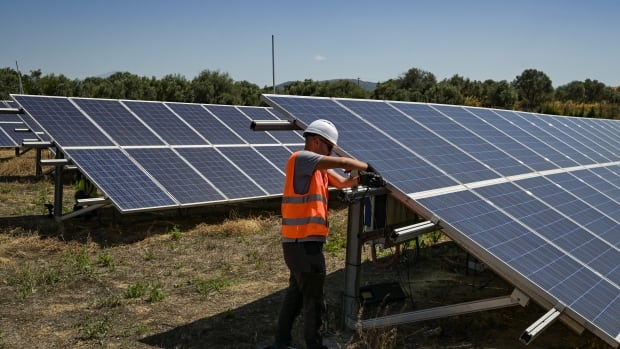Science
Solar Power Surges to Lead EU Electricity Generation in June

Data from the energy think tank Ember reveals that solar power became the largest source of electricity in the European Union for the first time in June 2023. Solar energy accounted for 22.1 percent of the EU’s electricity generation, surpassing both nuclear and wind power, while coal’s contribution fell to an all-time low.
The report indicates that solar generated 45.4 terawatt hours of electricity last month, a significant increase from 18.9 percent in June 2022. Nuclear energy followed closely behind at 21.8 percent, while wind energy contributed 15.8 percent to the overall mix. Notably, at least 13 EU countries, including Germany, Spain, and the Netherlands, experienced record monthly solar generation.
“This milestone shows how rapidly the EU’s power system is changing,” stated Chris Rosslowe, senior energy analyst at Ember and lead author of the report. “Solar is stepping up when it’s needed most – during summer heat waves and peak demand.”
Coal’s Decline and Electricity Demand Trends
Coal’s share of the EU electricity mix dropped to a record low of 6.1 percent in June, down from 8.8 percent the previous year, with a 28 percent reduction in electricity generated compared to last June. Germany and Poland, which together produced nearly 80 percent of the bloc’s coal-fired electricity in June, also recorded significant declines. In Germany, coal made up 12.4 percent of the electricity mix, while in Poland, it accounted for 42.9 percent.
In contrast, Spain approached a full phase-out of coal, generating only 0.6 percent of its electricity from this source during the same period. Wind power saw a resurgence, setting new records in both May and June following a sluggish start to the year due to unfavorable wind conditions. Despite these advancements, fossil fuel usage in the first half of 2023 increased by 13 percent, largely due to a 19 percent rise in gas generation to compensate for lower hydro and wind output earlier in the year.
Electricity demand in the EU grew by 2.2 percent in the first half of 2023, with five of the first six months showing year-on-year increases. Ember’s report highlights that the next challenge for Europe’s power system is to enhance battery storage and grid flexibility to decrease reliance on fossil fuels during non-solar hours.
Comparative Solar Power Growth in Canada
While solar power continues to gain traction in Europe, its growth in Canada remains modest. Dave Sawyer, Principal Economist at the Canadian Climate Institute, noted that the trend reflects a decreasing reliance on gas due to soaring prices, coupled with decreasing solar costs. “It’s really interesting to see what’s going on in Europe,” Sawyer remarked. “Batteries paired with solar, with the cheapness of that technology, is really driving the sort of penetration of solar into the system.”
In Canada, solar constitutes approximately 1 percent of electricity generation, but this figure is on the rise. Sawyer indicated that solar growth rates in the country have averaged about 13 percent annually over the past decade. Alberta, once heavily reliant on coal, has transitioned to receiving a larger share of its electricity from renewable sources.
Canada’s energy landscape differs significantly from the EU, primarily due to its abundant hydropower resources, which account for around 56 percent of electricity generation. Both regions have similar nuclear contributions, with Canada producing 16 percent and the EU 21 percent from nuclear power. Wind energy represents 10 percent of Canada’s electricity mix, compared to 16 percent in the EU.
As Canada works on expanding its battery storage capacity, Sawyer emphasized the need for affordable energy solutions to support increasing electrification, including heat pumps and electric vehicles. “Frankly, we need the politics to be toned down, and we need to look at these things in a reasonable fashion and build out what really produces cheap, reliable electricity for everybody,” he added.
The rise of solar energy in the EU exemplifies a significant shift in power generation dynamics, reflecting broader trends in the transition toward renewable energy sources. As countries adapt to changing energy landscapes, the path forward will require continued innovation and investment in technology to ensure a sustainable future.
-

 World3 months ago
World3 months agoScientists Unearth Ancient Antarctic Ice to Unlock Climate Secrets
-

 Entertainment3 months ago
Entertainment3 months agoTrump and McCormick to Announce $70 Billion Energy Investments
-

 Science3 months ago
Science3 months agoFour Astronauts Return to Earth After International Space Station Mission
-

 Lifestyle3 months ago
Lifestyle3 months agoTransLink Launches Food Truck Program to Boost Revenue in Vancouver
-

 Technology2 months ago
Technology2 months agoApple Notes Enhances Functionality with Markdown Support in macOS 26
-

 Top Stories1 week ago
Top Stories1 week agoUrgent Update: Fatal Crash on Highway 99 Claims Life of Pitt Meadows Man
-

 Sports3 months ago
Sports3 months agoSearch Underway for Missing Hunter Amid Hokkaido Bear Emergency
-

 Politics2 months ago
Politics2 months agoUkrainian Tennis Star Elina Svitolina Faces Death Threats Online
-

 Technology3 months ago
Technology3 months agoFrosthaven Launches Early Access on July 31, 2025
-

 Politics3 months ago
Politics3 months agoCarney Engages First Nations Leaders at Development Law Summit
-

 Entertainment3 months ago
Entertainment3 months agoCalgary Theatre Troupe Revives Magic at Winnipeg Fringe Festival
-

 Politics1 week ago
Politics1 week agoShutdown Reflects Democratic Struggles Amid Economic Concerns





















